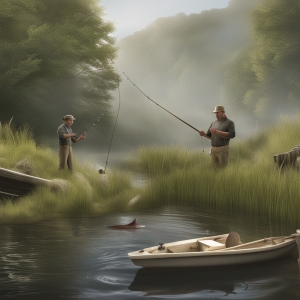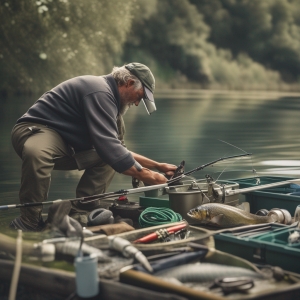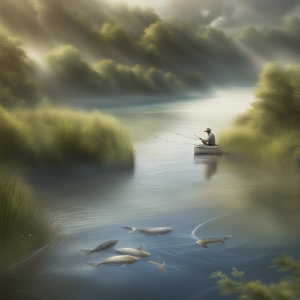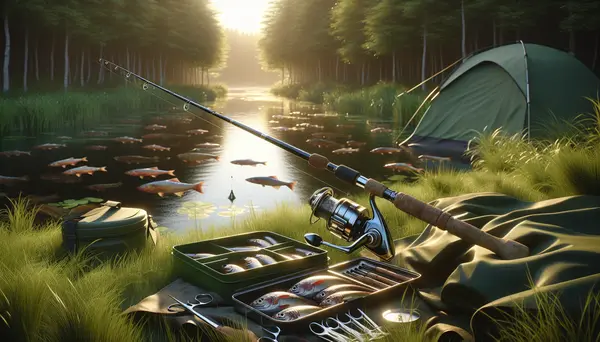Table of Contents:
Introduction: The Importance of Sustainable Angling
The beauty of a well-cast line, the gentle tug of a fish, and the shared stories beside the fire highlight the allure of angling. Angling is more than a popular recreational activity, it aids in understanding the aquatic ecosystem and our relationship with nature. However, in a world of dwindling fish populations and fragile ecosystems, sustainability must be at the forefront of every angler's mind.
Sustainable angling is the practice of fishing in a way that ensures the long-term health and stability of fish stocks. This method minimally impacts the environment and promotes the conservation of aquatic life. Moreover, it allows future generations to continue to enjoy the benefits of fishing.
The objective of this article is to shed light on why sustainable angling is critical, and introduce some resource-conserving practices to maintain and conserve fish stocks. These practices enable us to continue enjoying fishing while preserving the beauty and diversity of our lakes and rivers.
Understanding Overfishing: Why Sustainable Practices are Crucial
Overfishing occurs when more fish are caught than the population can naturally replace. As a result, species can quickly become depleted or even extinct, disrupting delicate aquatic ecosystems. Overfishing can decay the entire aquatic food chain, leading to repercussions for all of its inhabitants, from the smallest invertebrates to the largest predators.
The reasons why overfishing happen are manifold: from commercial fishing and aquaculture to illegal, unreported, and unregulated (IUU) fishing. Not to mention accidental bycatch (the unintentional capture of non-target species while fishing).
Thankfully, sustainable angling is a huge safeguard against these threats. While it doesn't solve all the problems, it certainly plays a significant part in the solution. By being mindful of when, where, and how we fish, we can make sure the places we love today will be around for generations to come.
Advantages and Disadvantages of Sustainable Angling Practices
| Pros | Cons |
|---|---|
| Preservation of Biodiversity | Possible need for more rigorous enforcement of rules |
| Sustainable recreation activity for future generations | Limited catch allowance might affect commercial fishermen |
| Improvement of local community economies through sustainable tourism | Initial setup costs for sustainable angling structures might be high |
| Positive impact on the ecosystem by maintaining the natural balance of species | Regulation and monitoring could be challenging in vast water bodies |
What is Sustainable Angling?

Sustainable angling refers to fishing practices that ensure the long-term conservation of fish species, their habitats, and broader ecosystems. The approach considers not only our present needs but also the needs of future generations. By practicing sustainable angling, we are striving towards the achievement of a balance – a balance where fish populations can replenish themselves and maintain their important roles within their ecosystems.
Sustainable angling goes beyond self-regulatory fishing limits. It incorporates respect for local rules, regulations, and customs, appreciating local habitats and acknowledging the importance of releasing caught fish under certain circumstances. The detailed practices of sustainable angling can vary depending on location, fish species, and specific local challenges. However, the central principle remains consistent – minimizing harm to fish and their environments, and contributing where possible to their ongoing survival and health.
So, what can you do to contribute to sustainable angling? Here are a handful of resource-conserving strategies that every angler should embrace.
Practical Angling Tips for Conserving Fish Populations
Embracing sustainable angling means adapting practices that ensure the conservation of fish populations. Here are some key steps that every angler should consider:
1. Practice Catch and Release: The concept is simple - after catching the fish, you let it go. Releasing your catch helps to preserve fish populations, especially during spawning periods. When releasing fish, handle them gently to minimize stress and physical harm.
2. Use Circle Hooks: Compared to traditional 'J' hooks, circle hooks are less likely to be swallowed by fish, reducing internal injuries and increasing survival rates upon release. They are designed to hook the fish in the lip or corner of the mouth, making it easier to achieve a quick, clean release.
3. Respect Size and Bag Limits: Be knowledgeable about size and bag limits put in place by local fishery authorities. These regulations are designed to protect fish populations and habitats. Respecting them is a crucial part of sustainable angling.
4. Use Ethical Bait: Choosing an ethical bait is essential. Avoid introducing non-native species to prevent potential ecosystem imbalance. Whenever possible, use artificial lures and flies. Not only are they reusable, but they also limit the transfer of diseases to fish populations.
5. Engage in Habitat Restoration: Participate in river cleanup initiatives, tree planting, and other conservation activities. A healthy habitat leads to flourishing fish populations.
Through these steps, every angler can contribute to sustainable fishing practices, ensuring that our precious aquatic resources are preserved for years to come.
Choosing the Right Gear: A Key Step Toward Sustainable Angling

Every seasoned angler knows that the type of gear you use can make or break your fishing experience. But did you know that your choice of equipment can also affect the sustainability of your angling practices?
There are three main points to consider when choosing your angling gear with sustainability in mind: the type of hook, the type of line, and the choice of bait.
1. Opt for Barbless Hooks: Barbless hooks cause less damage to fish and make the release faster and smoother. They are especially useful for catch-and-release fishing.
2. Choose Biodegradable Fishing Line: Lost or discarded fishing line can harm wildlife and negatively impact ecosystems. Biodegradable fishing lines are a more environmentally-friendly alternative, as they decompose naturally over time.
3. Use Artificial Lures: Artificial lures can be less harmful to the environment than live bait. They avoid the risk of introducing non-native species into the ecosystem and are less likely to be ingested by fish, reducing injury.
Paying attention to the impact of your gear and making a few simple switches can go a long way in promoting sustainable angling practices. While the initial effort may seem small, these changes collectively can contribute significantly to the conservation of fish stocks and the overall health of our precious water ecosystems.
Catch and Release: A Strategy for Conservation
The practice of 'catch and release' is the cornerstone of sustainable angling. It stresses on the importance of letting the fish go alive back into its habitat after the thrill of the catch. This allows the fish to continue contributing to its ecosystem, enabling it to reproduce and ensure the survival of its species.
Successful catch and release necessitates careful handling of the fish to avoid causing it stress and injury. Anglers should keep the fish in the water as much as possible while removing the hook. Wetting your hands before handling the fish can also help protect their sensitive scales and skin.
Moreover, if the fish is deeply hooked, it's better to cut the line as close to the hook as possible rather than trying to remove it. The hook will eventually dissolve without long-term harm to the fish. Anglers who regularly practice catch and release often opt for barbless hooks to make the release as smooth as possible.
'Catch and release' echoes the fundamental ethos of sustainable angling - getting joy from the activity without depleting the resources it depends upon. This way, anglers can ensure that populations of our favorite fish will remain abundant for future generations to cherish.
The Benefits of Sustainable Angling for the Environment and Fisheries

When we implement sustainable angling, it creates a ripple effect. While the direct benefits are to fish stocks and their associated habitat, the positive impacts also extend to the broader environment and fisheries at large.
Firstly, sustainable angling aids in preserving biodiversity. Healthy fish populations are a clear sign of a thriving aquatic ecosystem. Our rivers, lakes, and oceans are home to a vast diversity of life. By ensuring the survival and growth of varied species, we are effectively preserving this intricate web of aquatic life.
Secondly, maintaining sustainable fish stocks is central to the health of our commercial and recreational fisheries. Fishing is a vital industry for many coastal and inland communities worldwide. It provides livelihoods, contributes to economies, and offers recreational activities for millions of people. Sustainable angling practices make sure these benefits continue for generations to come.
Moreover, by adopting ethical and sustainable practices, we also inspire other outdoor enthusiasts to follow suit. This way, sustainable angling becomes a potent tool for raising widespread awareness about conservation, fostering a collective appreciation and respect for our natural resources.
Involving the Larger Angling Community: Spreading the Word about Sustainable Practices
Sustainability thrives on community involvement and awareness. The concept of sustainable angling can do a lot of good, but only if it's widely adopted and practiced. That's why it's crucial to involve the larger angling community in these conservation efforts.
Education and Awareness: Start by educating fellow anglers about the importance of sustainable fishing. Share your knowledge about catch and release techniques, the correct use of gear, and the significance of respecting local regulations. Encourage them to understand the consequences of overfishing and the importance of maintaining the balance in our aquatic ecosystems.
Attend and Organize Events: Community events centered around sustainable angling can spread the word powerfully. Attend these events to learn more and meet like-minded individuals. You can also organize such events to raise awareness in your local community.
Participate in Conservation Efforts: Your active participation in habitat cleanups, fish population studies, and other conservation initiatives can influence others to do the same. Show them that sustainable angling is not just about responsible fishing; it's also about taking responsibility for our shared environment.
Share Your Sustainable Angling Experiences: Talk about your sustainable angling experiences online - through social media, blogs, forums, or any other platform that can reach your fellow anglers and aspiring fishers. Your stories, tips, and insights could inspire others to adopt similar practices.
While sustainable angling starts with individual action, its true power is unlocked when it's embraced by the wider angling community. It's a team effort, and every angler's contribution counts towards the conservation of our precious fish stocks.
Conclusion: Our Collective Responsibility for Sustainable Angling
As anglers, we share a deep connection with nature and a profound love for the outdoors. This passion places upon us a vital duty to ensure the sustainability of our beloved pastime. We all have a role to play in protecting fish populations and ensuring the health and diversity of our aquatic ecosystems. By embracing the practices of sustainable angling, we can contribute significantly towards the conservation of our waters and the life they harbor.
Our impact as individuals may seem small, but united, we can effect drastic change. Incorporating sustainable practices into our angling isn't just beneficial - it's essential for the future of fishing. Remember, every cast we make can either contribute to the problem or be part of the solution. Let's choose the latter and become responsible stewards of our waters. After all, our actions today will determine the future of angling for generations to come.
FAQ zu nachhaltigem Angeln und dem Erhalt von Fischbeständen
Was versteht man unter nachhaltigem Angeln?
Nachhaltiges Angeln beinhaltet Praktiken und Regeln, die zum Schutz und zur Erhaltung der Fischbestände und des Ökosystems beitragen. Dazu gehört zum Beispiel das Fangen nur bestimmter Arten und Größen, das Vermeiden von übermäßigem Fischfang und die Wiederverwendung von Angelgeräten.
Warum ist das Thema nachhaltiges Angeln wichtig?
Nachhaltiges Angeln ist wichtig für die Erhaltung der Fischbestände und des Ökosystems. Übermäßiger und nicht regulierter Fischfang kann zu einem drastischen Rückgang der Fischpopulationen und zu Veränderungen im Ökosystem führen.
Wie kann man nachhaltig angeln?
Es gibt viele Maßnahmen, die man beim Angeln ergreifen kann, um die Praxis nachhaltiger zu gestalten. Dazu gehören der richtige Fang und die richtige Handhabung von Fischen, um deren Überlebenschancen zu erhöhen, der Verzicht auf den Fang gefährdeter Arten und die Verwendung von Geräten, die den Fischen wenig Schaden zufügen.
Welche Ausrüstung ist für das nachhaltige Angeln empfehlenswert?
Für nachhaltiges Angeln ist Ausrüstung empfehlenswert, die weniger schädlich für die Fische ist. Dazu gehören zirkelhaken, die dazu beitragen, dass die Fische beim Fang weniger verletzt werden, und sinkende Angelköder, um die Fänger von Oberflächenfischen zu reduzieren, die nicht überleben, wenn sie freigelassen werden.
Welche Gesetze und Vorschriften gelten für das nachhaltige Angeln?
Die Gesetze und Vorschriften für nachhaltiges Angeln variieren je nach Land und Region. In der Regel gibt es jedoch Beschränkungen hinsichtlich der Größe und der Arten der Fische, die man fangen darf, sowie der Fangtechniken und Geräte, die man verwenden darf.







